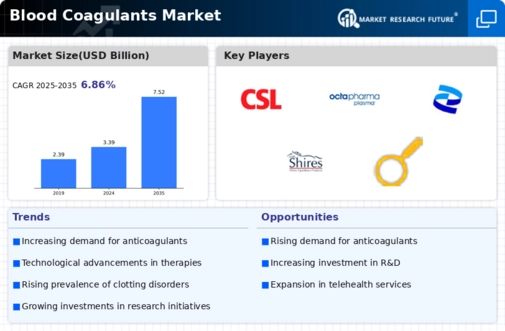Market Growth Projections
The Global Blood Coagulants Market Industry is poised for substantial growth, with projections indicating a market size of 3.39 USD Billion in 2024 and an anticipated increase to 7.52 USD Billion by 2035. This growth trajectory reflects a compound annual growth rate (CAGR) of 7.51% from 2025 to 2035. Such figures underscore the increasing demand for blood coagulants driven by various factors, including rising incidences of coagulation disorders, advancements in medical technology, and the growing number of surgical procedures. These projections highlight the market's potential and the need for continued innovation in blood coagulation therapies.
Advancements in Medical Technology
Technological advancements in the medical field are significantly influencing the Global Blood Coagulants Market Industry. Innovations such as recombinant factor therapies and point-of-care testing devices enhance treatment efficacy and patient outcomes. These advancements not only improve the management of bleeding disorders but also facilitate timely interventions. For example, the development of new synthetic coagulants offers alternatives to traditional therapies, expanding treatment options for patients. As these technologies continue to evolve, they are likely to drive market growth, with projections indicating a market size of 7.52 USD Billion by 2035.
Growing Demand for Surgical Procedures
The rising number of surgical procedures globally is a key driver for the Global Blood Coagulants Market Industry. As surgical interventions become more common, the need for effective hemostatic agents increases. Blood coagulants play a crucial role in managing bleeding during and after surgeries, thereby enhancing patient safety. For instance, the World Health Organization estimates that approximately 234 million surgical procedures are performed annually worldwide. This growing demand for surgical interventions is expected to propel the market forward, as healthcare providers seek reliable solutions to minimize bleeding risks.
Rising Incidence of Coagulation Disorders
The increasing prevalence of coagulation disorders globally drives the Global Blood Coagulants Market Industry. Conditions such as hemophilia and von Willebrand disease are becoming more common, necessitating effective treatment options. For instance, hemophilia affects approximately 1 in 5,000 male births, highlighting the need for specialized blood coagulants. As awareness and diagnosis improve, the demand for these products is expected to rise significantly, contributing to the market's growth. The market is projected to reach 3.39 USD Billion in 2024, reflecting the urgent need for innovative therapies to manage these disorders.
Rising Awareness and Education Initiatives
Increasing awareness and education initiatives regarding coagulation disorders are pivotal in shaping the Global Blood Coagulants Market Industry. Campaigns aimed at educating healthcare professionals and the public about the importance of early diagnosis and treatment are gaining traction. These initiatives help reduce stigma and encourage individuals to seek medical attention for bleeding disorders. As awareness grows, so does the demand for effective blood coagulants, which are essential for managing these conditions. This heightened awareness is expected to contribute to the overall market growth, aligning with the projected increase in market size.
Increased Investment in Healthcare Infrastructure
Investment in healthcare infrastructure, particularly in developing regions, is fostering growth in the Global Blood Coagulants Market Industry. Governments and private entities are increasingly allocating resources to improve healthcare facilities and access to essential medical products. This trend is particularly evident in regions with high incidences of bleeding disorders, where enhanced healthcare systems can facilitate better diagnosis and treatment. As healthcare access improves, the demand for blood coagulants is likely to rise, contributing to a projected CAGR of 7.51% from 2025 to 2035, indicating robust market potential.






